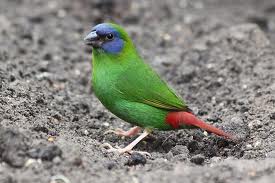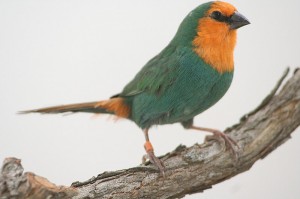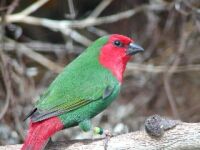Blue Faced Parrot for sale Sydney

Sexing and description of the Blue Faced Parrot Finches
When holding a pair together the male will have more blue on the face, grass green on the body. Often the blue does not pass the hens eye. The cock bird has a slightly darker blue on the face. Both sexes have a red tail area. These bird’s are around 12 cm long
Mutations of Blue Face Parrot Finches
There are different mutations of the Blue Face Parrot Finch, these are the Lutino Blue Face Parrot Finches and the Pied Blue Face Parrot Finches.
Comparability with other finches.
Like most types of parrot finches these guys are very active and are a great choice for a mixed species aviary they do mix well. Mixing finches
When purchasing your bird
Always make sure you choose a finch which has good condition on the breast area. Do not choose birds with closed eyes, fluffed up, scaly legs and beak. These birds moult very heavily so look for birds with good feather. Often in breeding season the hens can have a bare patch on the back of the head from male’s trying to mate.
What if I lose a mate?
In the unfortunate event one bird from a pair escaped or passes away, it is quite easy to partner the lone bird with a new partner. In the wild these birds often divorce and re marry. These birds are social so shouldn’t be in a cage alone.
Natural distribution of the Blue faced Parrot Finch
Blue faced finches are found in North Queensland and Papua New Guinea and surrounding islands. I was lucky enough after many days shacked up in the rainforest to spot and photograph these exclusive guys in the wild, I was only an hour north of Port Douglas in far North Queensland. They live deep in small pockets of cleared areas where grass is able to grow, in the rainforest.
Breeding Blue Faced Parrot Finches
Aviaries in my opinion are much better for all finches than breeding cabinets as the progeny seem to be happier and stronger from aviary bred birds.
These birds can breed all year round but generally breed in the warmer months of the year from October to April
Soft foods such as egg and biscuit can be fed to birds on a daily basis especially when breeding. Meal worms maggots and fly pupae are important to feed your finches especially when breeding. More on finch diet.
These birds will nest in both wicker nests or wooden semi open finch nest boxes both available at Birdsville. Do not inspect the nests too often when they breed to avoid the parents from deserting the young. They will use coconut fibres and blades of grass to construct the nest.
Eggs- around 5 eggs are laid 13 to 14 days to incubate the eggs.
Fledgling takes around 3 weeks and a further 5 weeks for the young to wean onto seed. Blue faces Very clean finches as the parents will remove the droppings of the nestlings to keep the nest clean until they leave the nest.
Diet for Blue Faced Parrot Finches.
Seed– Always feed your birds a good quality seed mix if you want any success in breeding them. A good quality seed mix’s are available in most pet stores and produce store’s. Many supermarket feed mix’s are poor quality and filled with filler seed and shell grit which is heavy to increase the weight of the product. Finches need to be in top condition if you want them to breed. This is why breeders are so fussy when it comes to the seed mix they feed there birds. If you are unsure of the seed mix you are using ask a bird specialist next time you see one.
Sprouted seed-A great addition to your finches diet but be sure to clean the seed thoroughly with aviclens to remove bacteria before feeding to your birds.
Millet sprays– A fresh seed still on the stem relished by finches, French white is the best for blue faced parrot finches.
Greens– are very important for the vitality of your Parrot finches and should not be ignored. These can be supplied in the forms of seeding grasses, chick weed, bok chou, lebanese cucumber and endive.
Live food– including meal worms and fly pupae, this can be fed with a few pinches of wombaroo insectivore mix. This is essential for breeding birds
Egg and biscuit formula- An important addition for extra protein especially for breeding birds This can be fed in conjunction with the live food mentioned above.
Vitamin Supplement- Essential to add what we can not provide in a active environment for finches, vitamins must be added to the water supply as vitamins added to seed will be wasted in the hulling process when finches feed.
Grit-A proper fine finch grit containing shell, baked egg shell, crushed cuttlebone, charcoal and limestone.
Never feed finches lettuce.
It’s important to worm your birds but keep in mind this species is especially sensitive to praziquantel, so please check your worming syrup doesn’t contain this.



